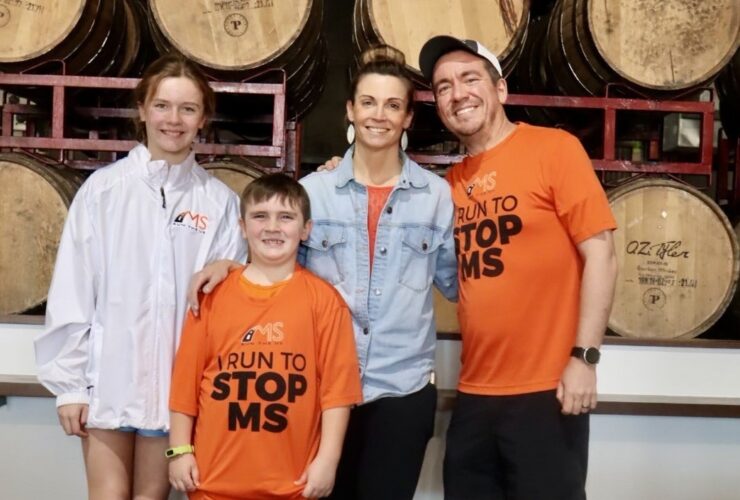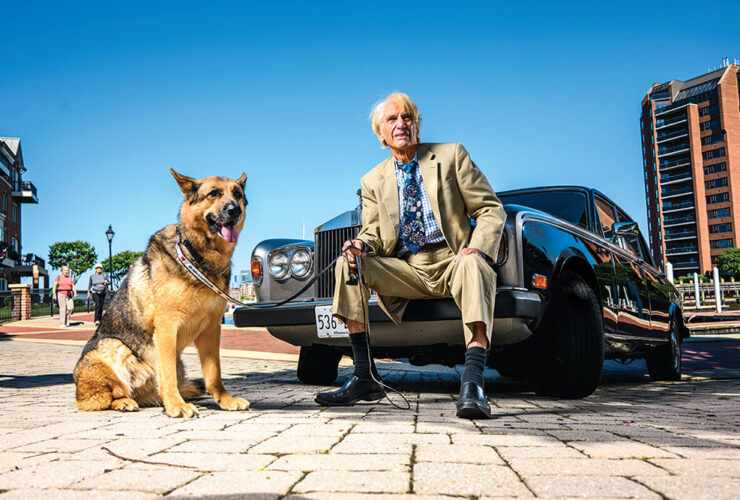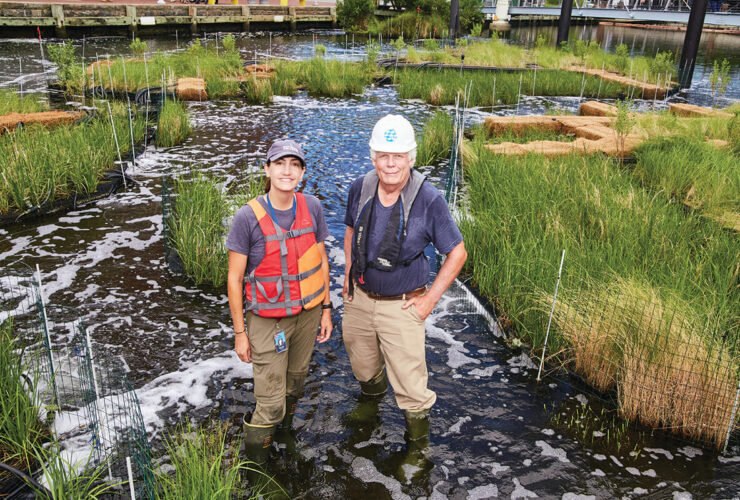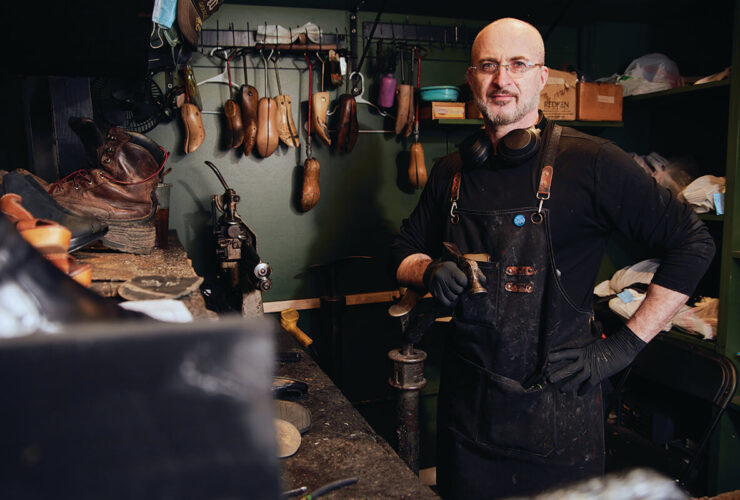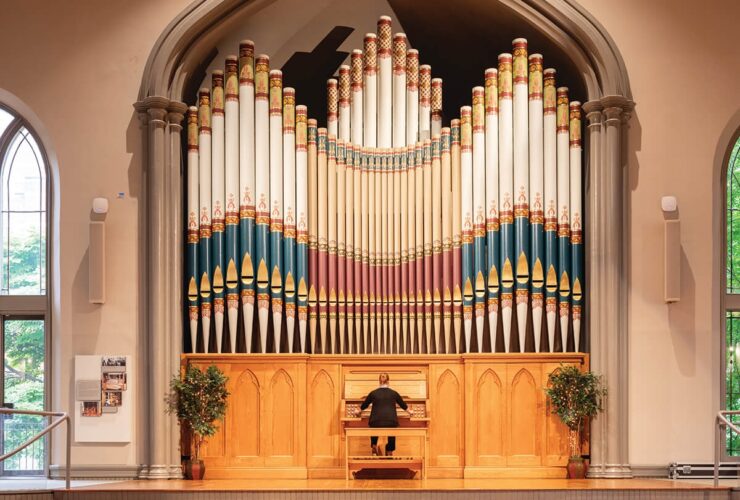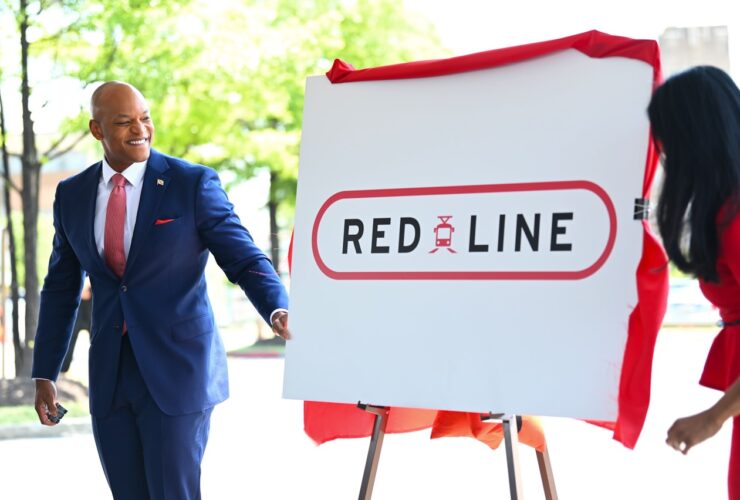
TRAVEL & OUTDOORS
Sustainable City
Climate change is having an impact, but organizations are working to make Baltimore more resilient, cleaner, and greener for all.
Edited by Christianna McCausland
Photography by J.M. Giordano
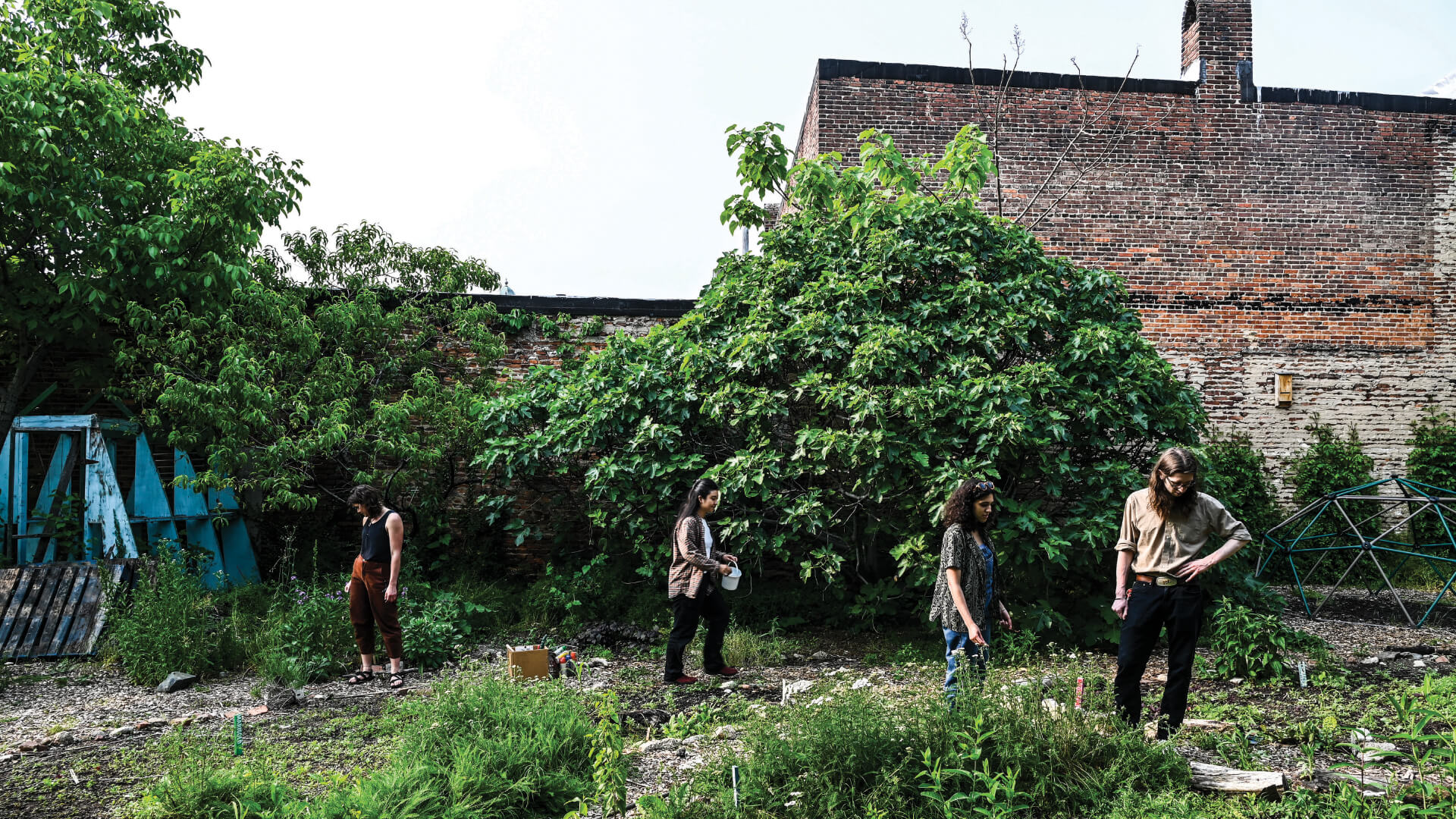

AST WINTER WAS THE FIRST WITHOUT SNOW in recorded memory, beating out 1949 when just .7 inches fell. February saw days in the 70s. These balmy interludes are not anomalies; research by the University of Maryland shows that average temperatures in the state have risen by about 2.5°F since 1900. Everything from the number of broiling days to storm intensity and flooding have increased. Our seasons are becoming less distinct and milder.
This adds up to a major challenge for a city like Baltimore. Covered in miles of asphalt and concrete, the city becomes a heat island on warm days. With sea levels projected to rise by as much as 1.6 feet by 2050, waterfront areas will deal with more flooding and property damage. Saltwater incursion into freshwater systems and agriculture will be problematic. Severe storms will lead to more runoff, erosion, and degradation of both soil and water.

And given Baltimore’s history of redlining, poor neighborhoods of color will continue to be disproportionately hit by global warming. Lacking trees and parks, they blaze on hot days; and heavy metals left behind from years of industry contaminate the soil. Baltimore is a city where life expectancy, access to nutritious food, and other health issues are often dictated by your ZIP code, a disparity writ large by climate change.
But amidst the doom and gloom there’s reason for hope. Just last year, global organization The Nature Conservancy launched a project focused on Baltimore’s Patapsco River Watershed, and Baltimore was one of only three cities nationwide awarded a $25-million federal grant to enable scientists, academics, and researchers to develop climate resilience strategies here.
City officials have also been moving toward a more sustainable future for years. The latest incarnation of the city’s Sustainability Plan, published in 2019 by the Baltimore Office of Sustainability (BOS) and anchored by the United Nations Sustainable Development Goals, sets forth bold benchmarks to make the city more resilient, help residents adapt to changing conditions—and to do so in a way that embraces racial equity and social justice.

“The Earth itself is incredible,” says Ava Richardson, director of BOS. “The Earth has been here for billions of years, and she will continue to be here. Our goal is to ensure that we are here and that we are able to live with high quality of life as her conditions change.”
Sustainability is a term that often gets bandied about without a clear definition. Richardson says it really comes down to preserving the natural resources we rely on. “We want to ensure that future generations have access to clean air, clean water, that they have a tree canopy that improves quality of life so that they are not living in a city that’s too hot in the summer months, especially if those summer months become longer and longer.”
We can already put a few things in the win column. Baltimore has adopted carbon emission reduction plans in line with the Paris Climate Agreement and nearly hit its goal to reduce emissions by 25 percent by 2020 (coming in at 23.2 percent). The city is committed to carbon neutrality by 2045. It’s estimated that the city’s ban on plastic bags has kept 12 million of the flimsy things out of the environment and trash wheels in the Harbor have collected over 2,300 tons of debris to date. The city is working to implement the Baltimore Green Network Plan to link existing green space with new parks and reimagined, verdant vacant lots to create sustainable corridors for people and wildlife.

Yet there’s more to be done and it starts at the individual level. Richardson says we must look closely at our consumer habits and waste less. “For many of us, we throw things away not necessarily considering where ‘away’ is or how much waste we produce in a particular day,” she says. Consider the lowly cigarette butt. One-third of the billions of cigarettes sold in the U.S. annually are flicked on the ground. Non-biodegradable, they wash into waterways, becoming the most common marine litter in the world.
Simple changes, like eliminating single-use plastic, driving a little less—single occupancy driving is a large contributor to air pollution—recycling correctly, and managing thermostat temperatures, do make a difference.
“I want everyone across our city to feel empowered and to know that your actions matter,” Richardson states. “We will need millions of actions from hundreds of thousands of residents across the city and the small micro actions that you take on a daily basis do contribute to our climate goals.”
There are many organizations working to make Baltimore more environmentally sound. Here, we highlight a few that are moving the needle on improved stewardship of the land, air, and water.
Opening spread: volunteers tend to hidden harvest farm’s garden on calvert street, downtown.
Pocket Park Protectors
Baltimore Green Space is securing today's land for tomorrow's well-being.
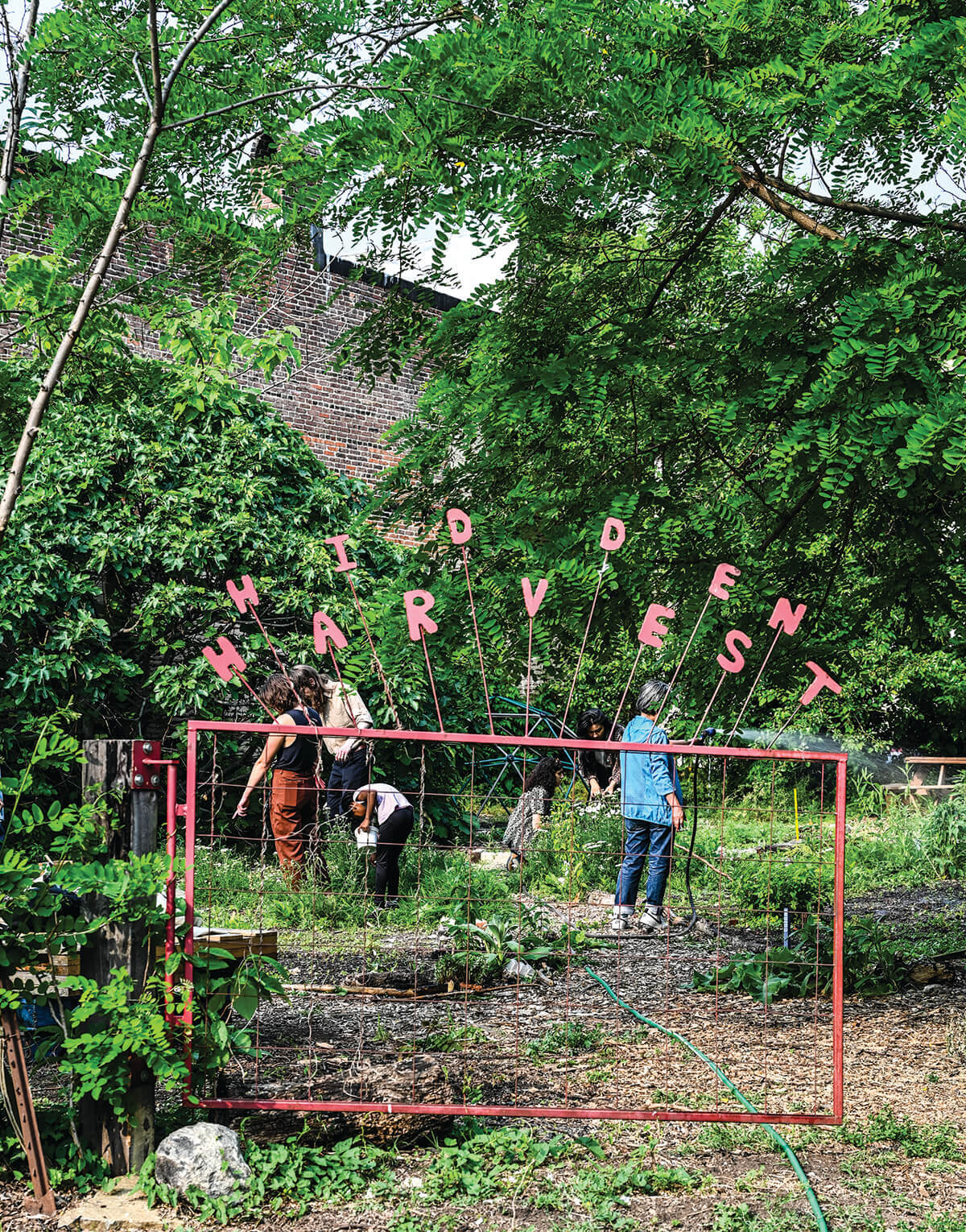
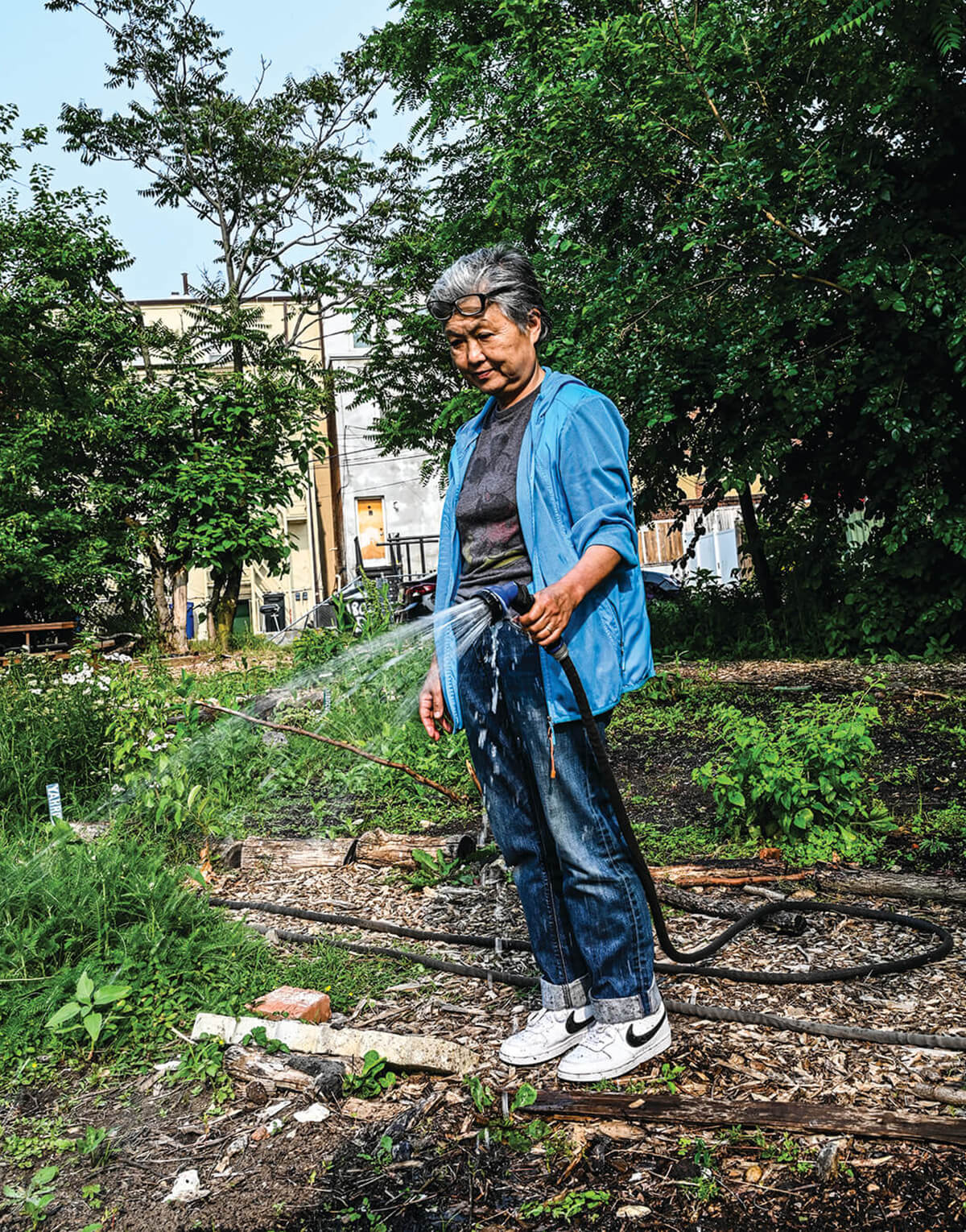
=

hink “land conservation” and huge tracts of open space will likely come to mind. But in Baltimore, you could walk right by a piece of preserved land and have no idea. The land conservation trust Baltimore Green Space (BGS) currently stewards 62 acres, much of it pocket parks or small urban forest patches. These little spots of green that pop up amid expanses of endless concrete play an important role in the city’s future sustainability.
“There’s a myth that there’s no real nature in the city,” says executive director Katie Lautar, who explains that, on the contrary, since the fall of Baltimore’s Rust Belt industries, abandoned lots of land have had decades to go completely wild. “We have herons living in the tiniest space you can imagine, and larger urban forests filled with endangered species, saplings, and streams.”
BGS was born out of one woman’s fight to protect her own pocket park from development. Since then, BGS has worked to protect existing green spaces that are being cared for by their community from the threat of development. Although BGS recently conserved the 54-acre Masonville Cove Urban Wildlife Refuge, most of its projects look more like Hidden Harvest Farm, pictured above, a half-acre community garden in Greenmount nurturing fruits, vegetables, even bees. Or Springfield Woods, 3.5 acres of 100-year-old forest just a short hop away from the rumbling traffic of The Alameda. Or the remarkably tiny Brentwood Commons, a patch of park less than a block off North Avenue and barely the size of a handful of rowhouses.
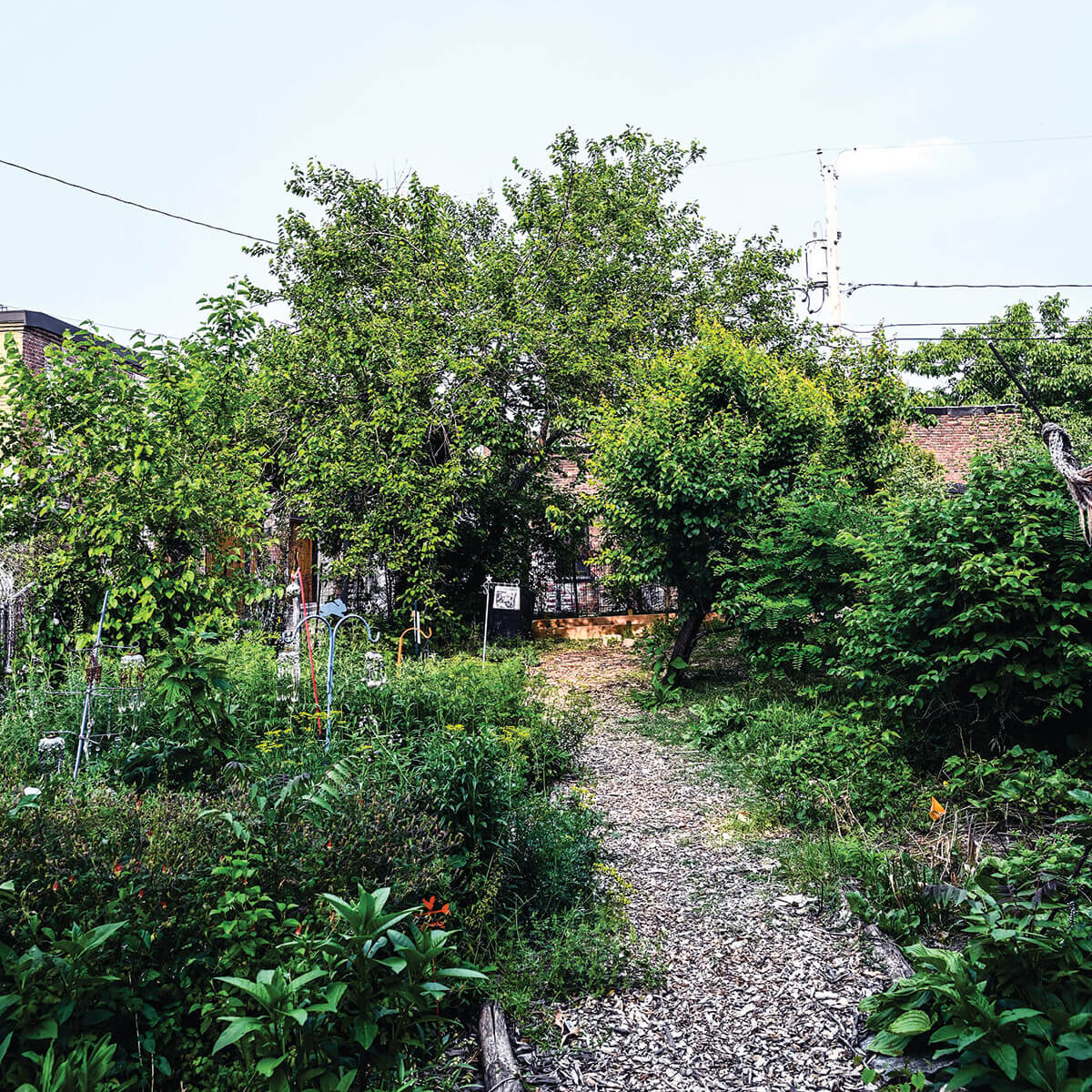
These tiny but mighty green spaces are essential to Baltimore’s future. They offer shade, yes, but also cool air and surface temperatures by moving water from the ground into the atmosphere while also absorbing carbon emissions.
Additionally, green spaces are important shelter areas for migratory birds—Maryland is centrally located on the Atlantic Flyway, used by millions of birds annually—and absorb stormwater so it doesn’t flood streets and rush into the Bay carrying trash and pollutants with it. From a quality-of-life perspective, there are numerous studies that show a bit of grass and a few trees improve both physical and mental health in humans.
While BGS works with the city to transfer land into conservation, “The majority of the vacant land in Baltimore is privately owned,” says Lautar, including more than 20 percent of the city’s current tree canopy. That leaves much of Baltimore’s green patchwork vulnerable to development.
Still, Lautar believes we’re moving into a better moment for conservation. As part of its advocacy work, BGS pushed for passage of the Greenspace Equity Program. Recently signed by Gov. Wes Moore, it supports green space in underserved communities, making it easier to acquire small plots of land. Lautar says preserving these spaces is essential to community health and well-being; many are neighborhood hubs, places for concerts, picnics, birthday parties, and more. Others are beloved for their serene natural beauty.
“We have over 800 green spaces and over 1,000 forest patches, so at least 2,000 green space assets we can invest in to make them more accessible, to create capital improvements on, and to employ community members in the care of,” she says.
“From an environmental perspective,” she continues, “we are really well-positioned to change the paradigm of how we think about cities making themselves climate resilient.”
What you can Do
Earth Movers


Engage with and share a green space

Replace asphalt with permeable pavers or plants
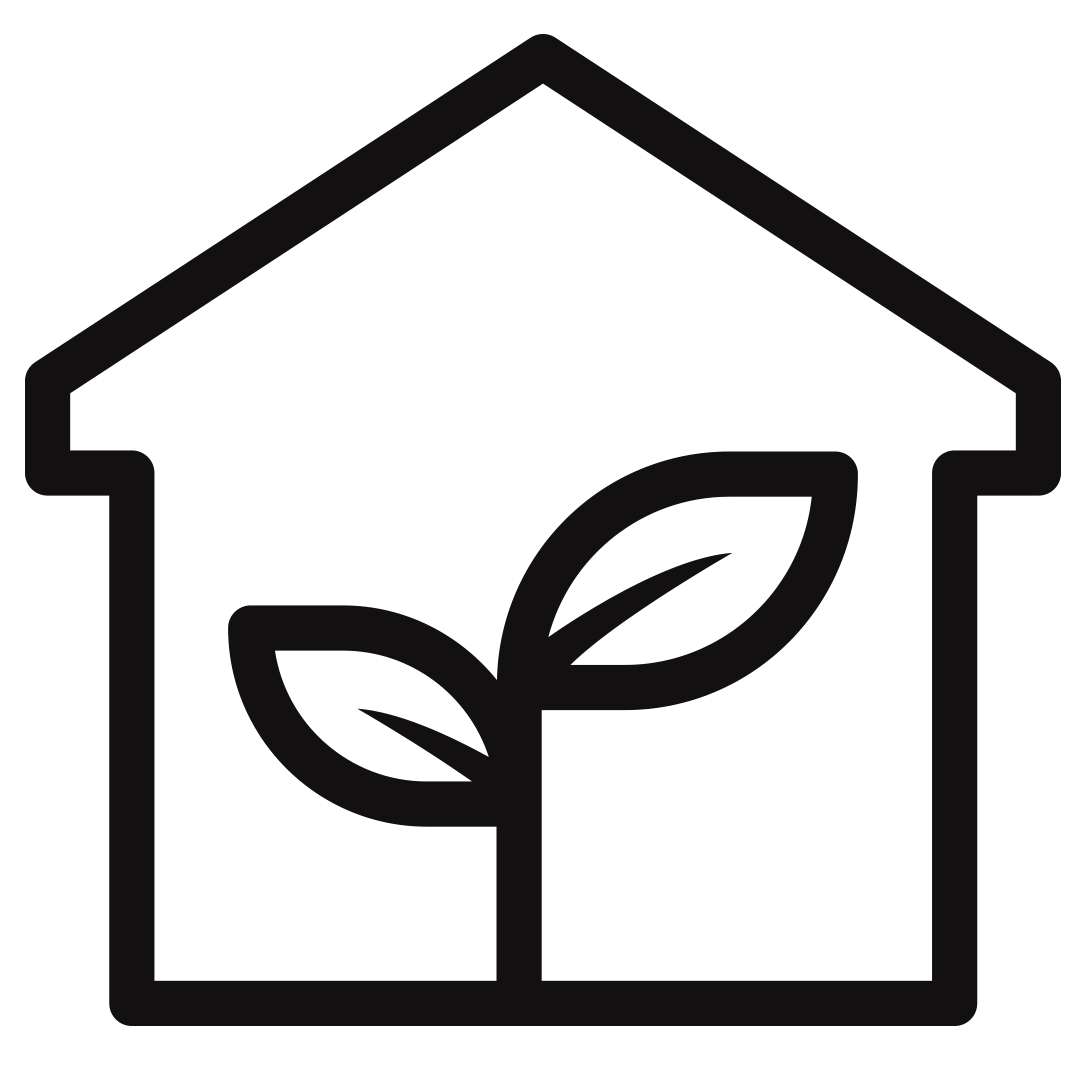
Consider planting a green roof

Purchase from local growers

Plant native species (even in containers)
Seeds of Change
Urban farms grow more than produce inside city limits.
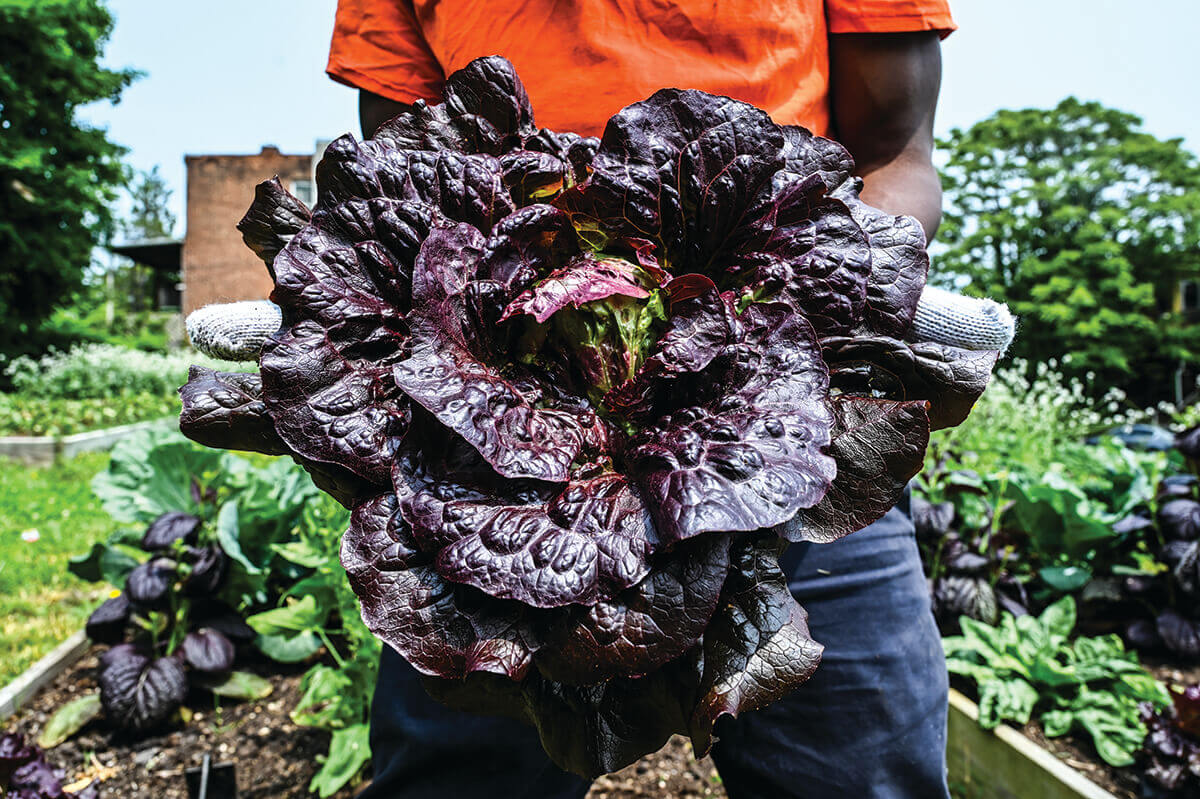
RICHARD FRANCIS, known to all as “Farmer Chippy,” pictured below, oversees 10 acres of land, cultivating everything from kale and mustard greens to herbs and peppers. He also has a flock of Rhode Island Red hens. But his garden isn’t laid out on pristine acreage; it’s carved out of city blocks on a stretch of Park Heights Avenue between Pimlico Racetrack and Druid Hills Park, an urban farm called Plantation Park Heights.
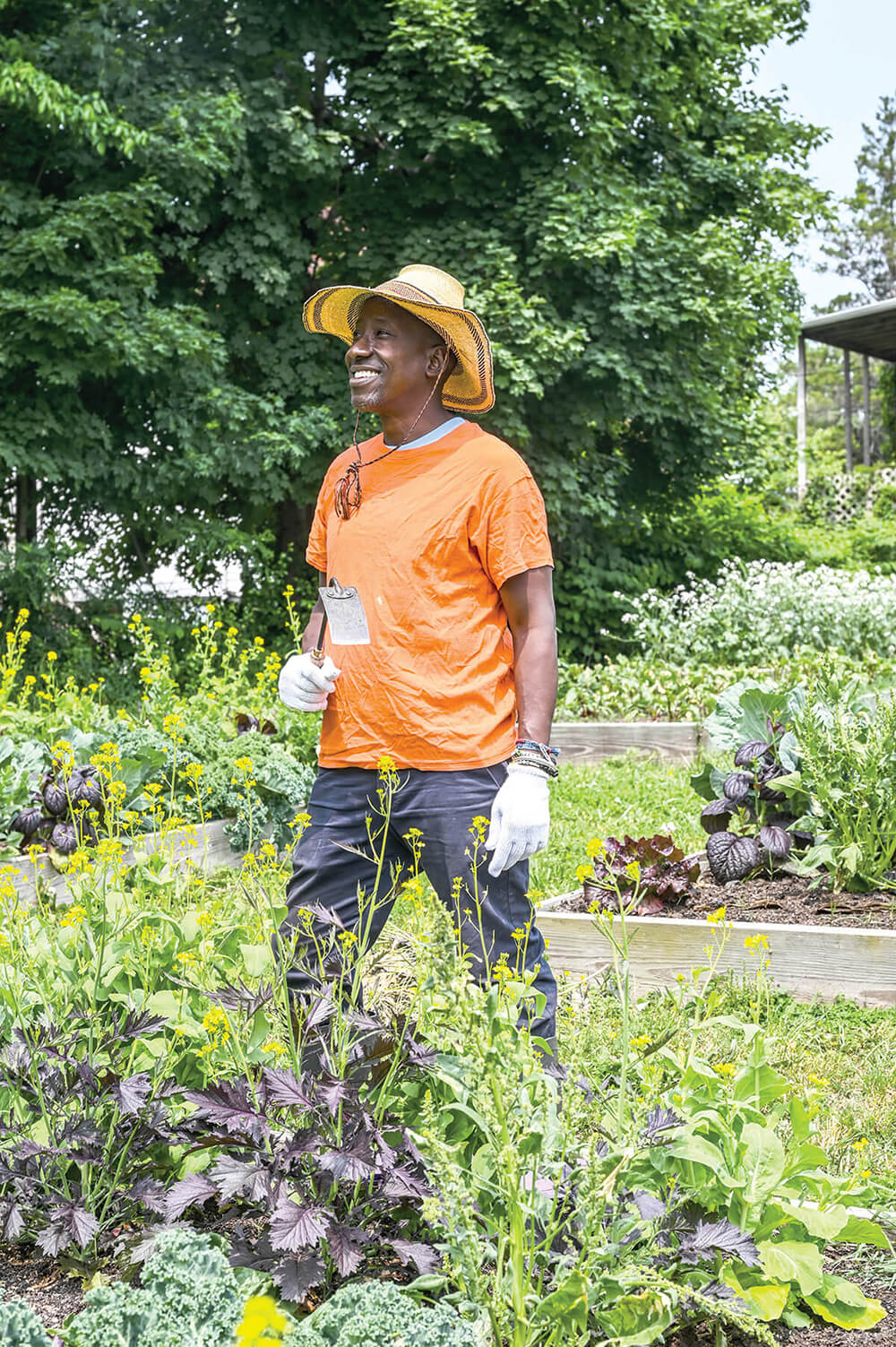
Farmer Chippy’s love of the land goes back to his upbringing in Trinidad and Tobago, but he’s been cultivating his little corner—or, more accurately, corners—of the city since 2014. He started squatting on an abandoned lot growing herbs and has expanded by purchasing and leasing one lot at a time. He now has two large hoop houses in addition to acres of raised beds maintained by 25 volunteer farmers. He calls it “AgriHood Baltimore.”
“We don’t just grow food and sell it, we grow people, we grow community, we nurture families so they stay together,” he says. He’s particularly interested in youth outreach, noting that the average age of a farmer in America is about 60. “Anyone can put up a farm; what we need is more farmers. This is a farmer-training institute, right here in the ’hood.”
As of 2019, there were 20 urban farms like Plantation Park Heights in Baltimore. Farms play an important role in the city’s sustainability. The green spaces and plants support biodiversity, help manage stormwater runoff, and mitigate the impact of heat islands. They support a circular system, too, where food waste can be composted and returned to soil in garden beds.
But the impacts are greater when it comes to food security, nutritional education, and community engagement. Plantation Park Heights sells its produce and eggs at Druid Hill Park and Johns Hopkins Hospital’s farmers markets, conducts cooking demonstrations at every farmers market they go to, offers training and workshops at the farm, and, each Thursday, gives away 200 boxes of fresh produce. “Urban agriculture brings people together to grow food in our community, for our community,” Farmer Chippy states.
Overstory Tellers
The Baltimore tree trust is growing and maintaining our urban forest.
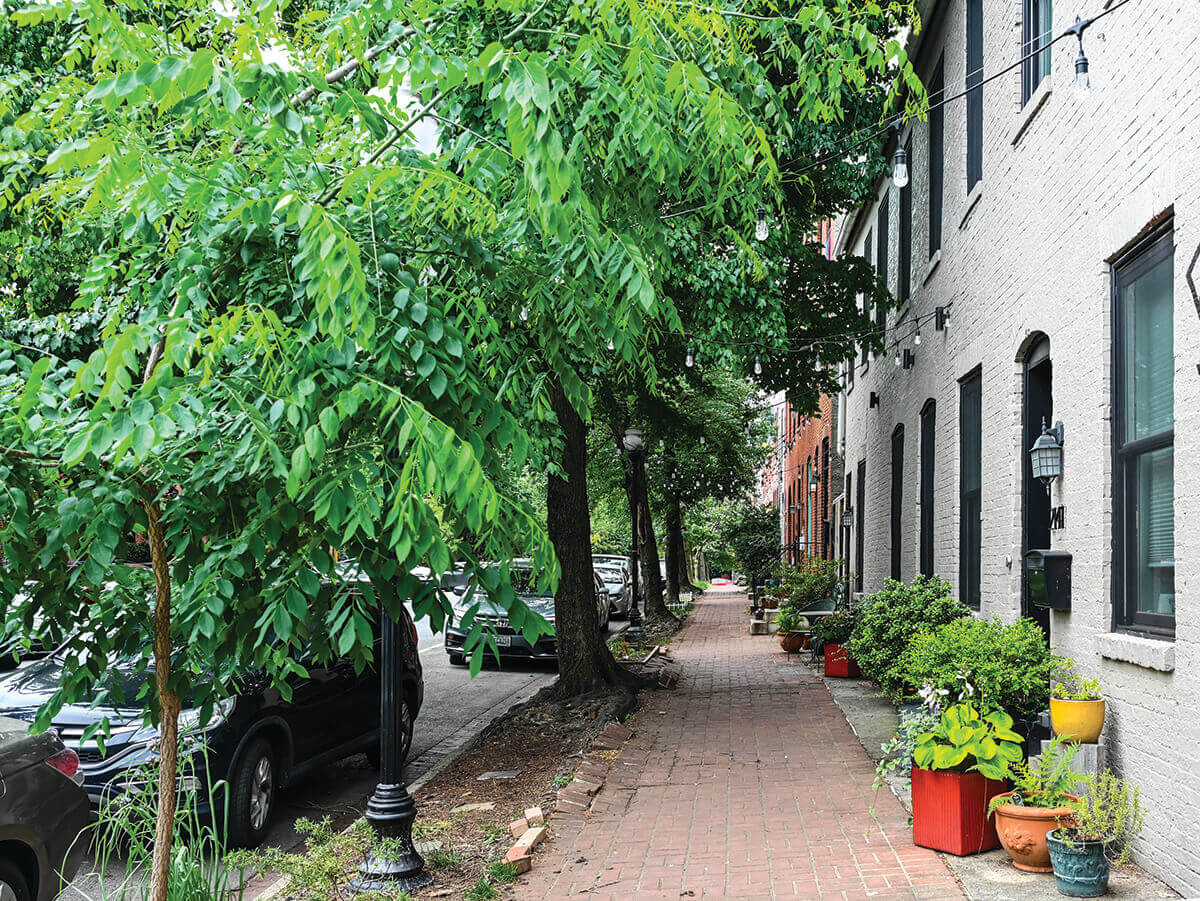

tep outside. If there’s a tree there, appreciate it not only for its beauty but also for the role it plays as part of Baltimore’s vast urban forest, thousands of arboreal acres that create a life-giving leaf canopy—the lungs of the city.
While Baltimore is home to the third-largest urban wilderness in the U.S. (Gwynn Falls Leakin Park), its forest is still not as big as it needs to be nor equitably distributed. Baltimore Tree Trust (BTT) is just one organization helping to grow the city’s tree canopy from its current 28 percent coverage to its goal of 40 percent, while ensuring trees get to neighborhoods in greatest need.
Trees have innumerable benefits. Studies show that tree-lined neighborhoods tend toward higher community engagement and lower crime. Trees slow stormwater runoff and create habitat for wildlife. They’re also critical in the fight against warming temperatures. Without shade from trees, neighborhoods scorch, experiencing temperatures at least 10 degrees warmer than their leafy counterparts. In this extreme heat, air quality—and human health—deteriorate. Natural resource consumption soars as residents who can access air conditioning shelter indoors.
“The science is there,” say BTT executive director Bryant Smith. “There are so many health problems tied to lack of tree canopy connected to heat-related issues that if we don’t target the neighborhoods that don’t have a high tree canopy rate, we’re creating an unsafe environment for those residents.”
Tree canopy maps show that while affluent neighborhoods have as much as 50 percent canopy coverage, that plummets to as low as six percent in underserved areas. Yet some people do not want a tree outside their house. (Those who do can request trees, here.) They fear property damage or mess from fallen leaves.
“Urban forestry does not just include trees,” says Smith. “We’re building a forest in a place where there are structures, buildings, people. So how do we, in a smart way, plant ‘right tree, right place?’ There needs to be education, community buy-in, and partnerships to not only get trees in the ground, but to maintain them.”
Everyone can help the city’s canopy. Simple acts of kindness like clearing tree wells of weeds and litter and watering your sidewalk trees in summer’s heat make a difference. Well cared for, an urban tree can live 60 to 80 years.
Smith says it’s a good time to be in urban forestry, with more investment than ever before. The Tree Solutions Now Act, for example, plans for five million trees to be planted in Maryland, including 500,000 trees earmarked for underserved urban areas. President Biden’s Inflation Reduction Act includes $1.5 billion to increase urban tree canopy nationwide.
BTT started out planting a few trees in East Baltimore; now they plant 6,000 a year. They’ve created an impervious surfaces removal arm that can do the work of cutting concrete sidewalks to make tree wells, clearing asphalt from vacant lots, and grinding stumps. Importantly, BTT’s career development arm, the Neighborhood Forestry Initiative, trains urban arborists so there will be professional stewards to care for the future forest.
What you can Do
A Breath of Fresh Air


Eat a plant-based diet (reduce food system-related emissions)

Plant a tree

Compost kitchen scraps

Get a free home energy audit

Curb your drive time
GOLD MINING
Baltimore Compost Collective wants to turn waste facility pollution into black gold.
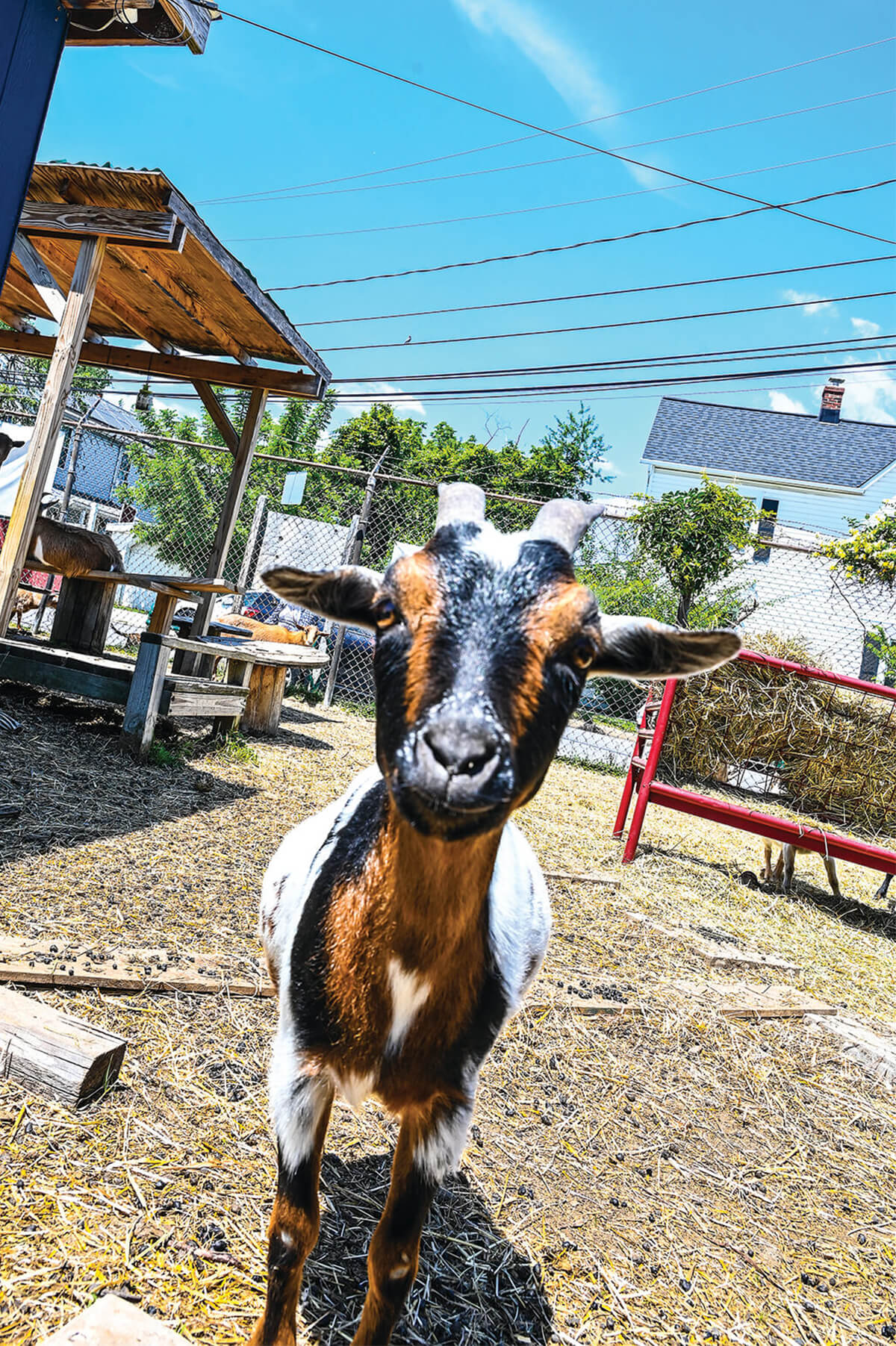
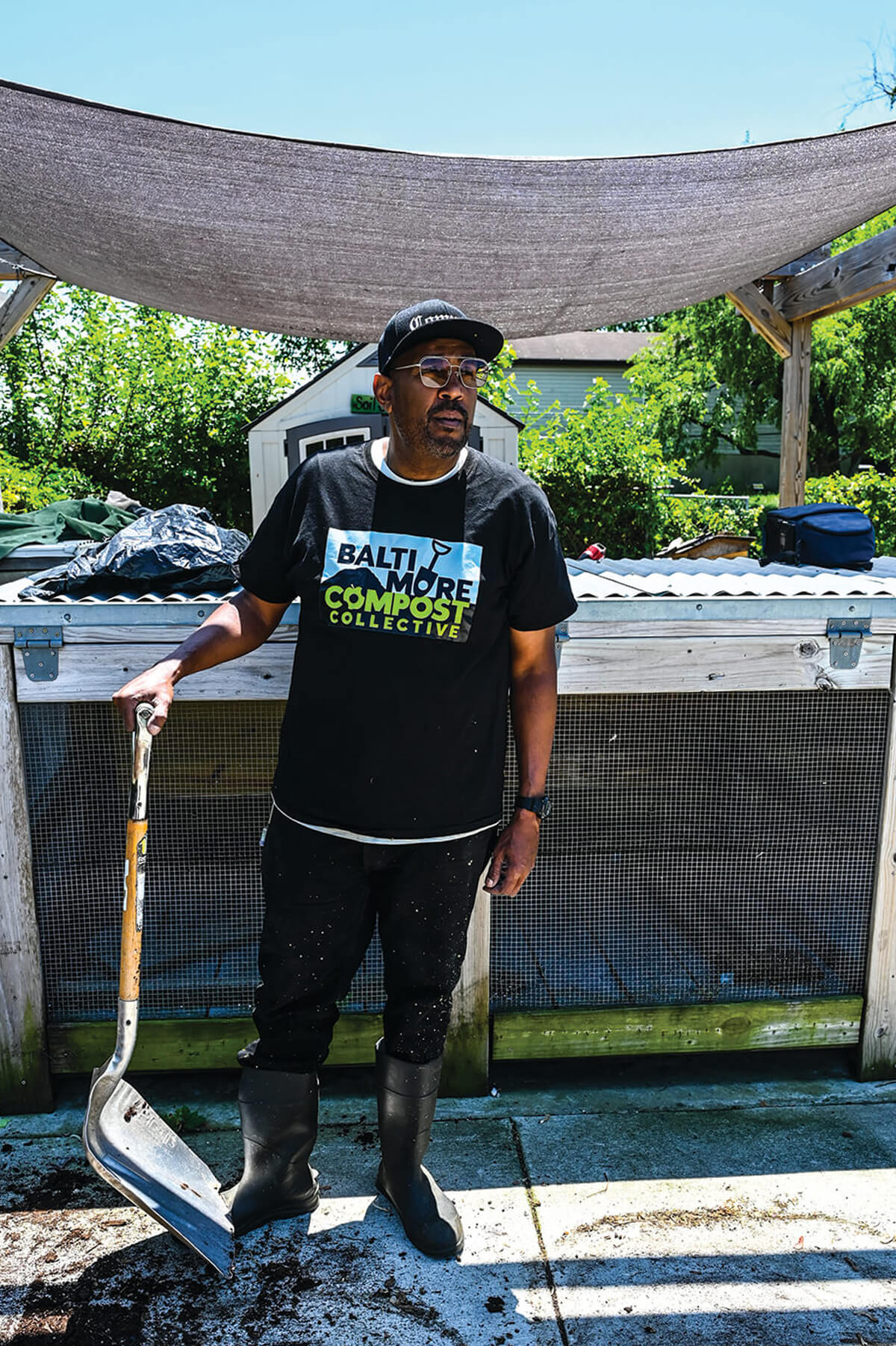
FROM LEFT: A RESIDENT GOAT; MARVIN HAYES.
BALTIMORE HAS COME a long way in reducing its greenhouse gas emissions, but according to the John Hopkins University Greenhouse Gas (GHG) Lab, there’s one sticking point—the Wheelabrator incinerator.
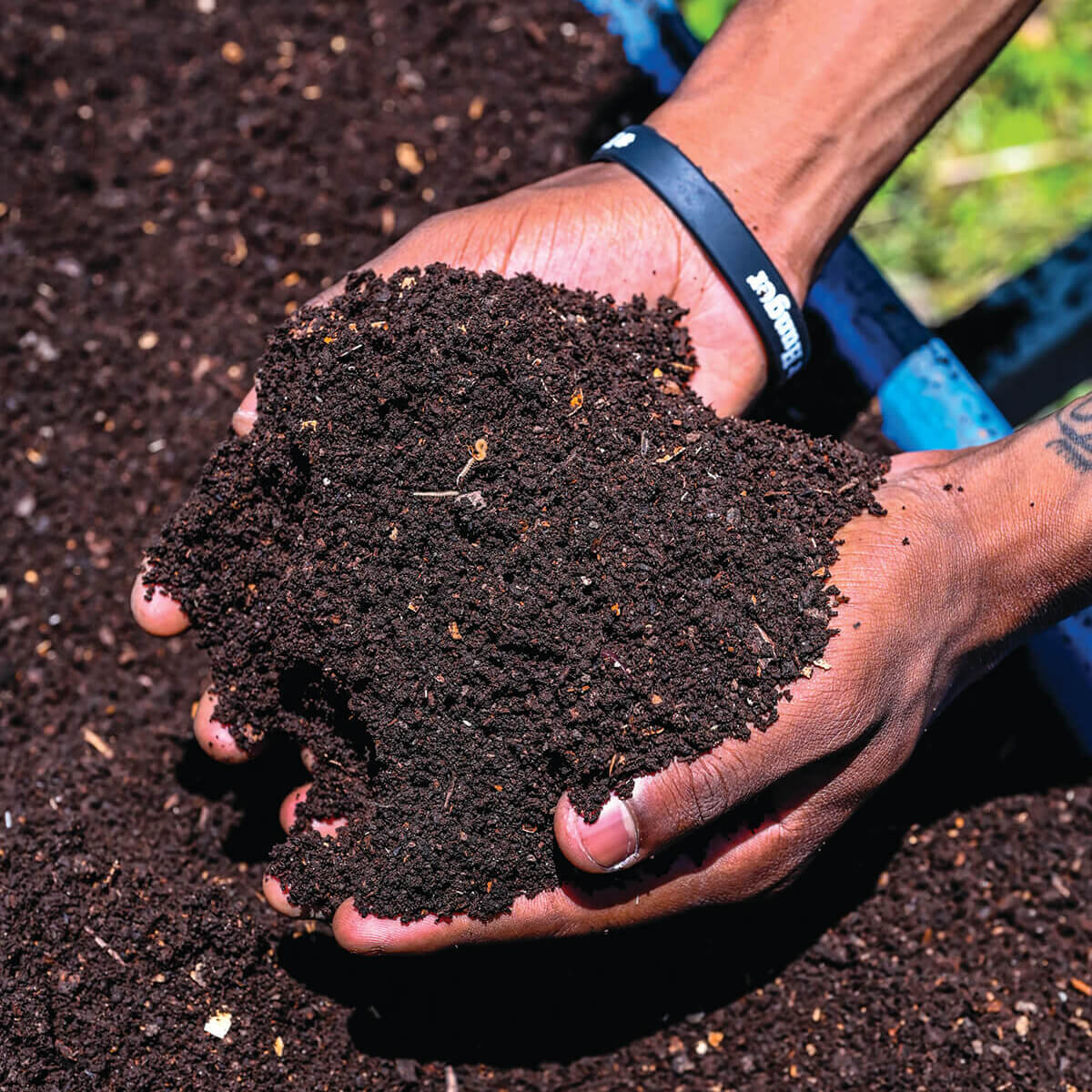
A HANDFUL OF COMPOST AT FILBERT STREET COMMUNITY GARDEN.
Located in South Baltimore, Wheelabrator’s emissions have not changed since JHU began monitoring it in 2007, and it is the largest source of GHG in Baltimore. Landfills are no better, generating potent methane, which traps heat and is largely responsible for global warming. All this air pollution is a public health problem; the BOS 2019 Sustainability Plan states that the city’s hospitalization rate for asthma is 2.5 times higher than the state average.
But so long as the city generates trash, it needs to go somewhere, right?
Marvin Hayes has a different solution: Starve the incinerator, feed the soil. As executive director of Baltimore Compost Collective, Hayes is practically evangelical about educating anyone who will listen about how common waste can be transformed into uncommon soil.
“People haven’t been educated here in the city about composting,” says Hayes. “That’s my job, to go out and tell them they can make a decision to divert their organic material from going into the landfills and incinerators.” He adds that “wind does not segregate or discriminate,” so air pollution from waste facilities in underserved communities is everyone’s problem.
The Collective distributes five-gallon buckets to clients, picks them up once a week, and takes them to the composting center located at Filbert Street Community Garden. A quarter of what we throw in landfills can be composted. Composting naturally breaks down household scraps—yesterday’s pasta, half-eaten apples, this morning’s coffee grounds—into what gardeners call “black gold,” the dark, rich humus essential to plant growth. Compost from the Collective remediated the soil at Filbert Street, enabling what was previously a dumping site to go from toxic to a neighborhood oasis with raised vegetable beds, a greenhouse, bees, fowl, and goats.
The Collective has 300 curbside clients and Hayes is collecting as much as 1,500 pounds of waste a week, more than he can manage. He takes the excess to a composting facility in Upper Marlboro, but he’s raising money and working with the city to expand his operation. “I want to build a large-scale, inclusive composting facility for Baltimore so we can have municipal, curbside composting for every resident in the city.”
Pollution Solutions
Gunpowder Valley Conservancy Safeguards the Headwaters that Feed the Bay.
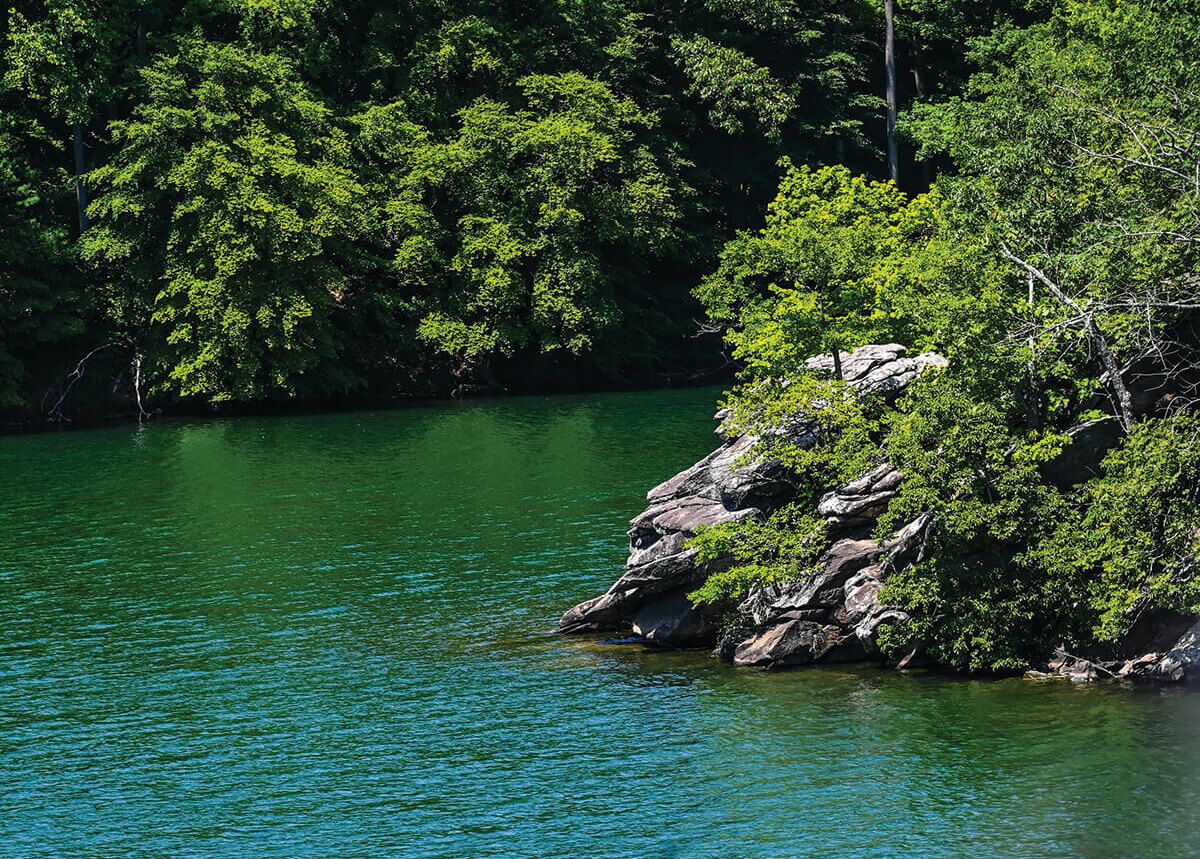
LOCH RAVEN RESERVOIR IN THE GUNPOWDER WATERSHED SUPPLIES MUCH OF THE CITY’S DRINKING WATER.

ooking at the Inner Harbor or boating out of Bowleys Quarters, it’s hard to believe the water there has been affected by what someone has done hundreds of miles away. Yet that’s the case with many of the watersheds that feed into the Bay. The Gunpowder Valley Conservancy (GVC), a land trust and watershed conservation organization, works to protect the Gunpowder watershed that begins at its headwaters in York, Pennsylvania, travels through networks of rivers and streams through Baltimore and Carroll counties, then empties into Middle River and, ultimately, the Chesapeake Bay.
Along the way, that water picks up everything we dole out: pesticides from agriculture, yes, but also fertilizer from lawns, litter, road salt, motor oil, and other contaminants. While Baltimore has real problems—leaking sewage pipes, dumping—GVC’s executive director, Kim Pause Tucker, says it’s easier to finger point at these bad actors than to look at how we as individuals impact water quality.
“A lot of people, if they don’t see a stream near them, don’t think they’re part of the watershed, but eventually all water goes into a storm drain or seeps into the water table,” says Tucker. While there is a Gunpowder Riverkeeper who is a steward of the actual water, GVC is focused on protecting water by protecting land (they have more than 2,000 acres of land in conservation easement, an agreement that permanently limits uses of the land in order to protect it).
That’s because much of what affects water quality takes place on the shore. GVC has planted a lot of trees, over 34,000. Deforestation causes erosion, filling streams with sediments that degrade the water quality and can pollute the environment for submerged aquatic vegetation (SAV). According to NOAA, healthy SAVs upstream reduce water acidity downstream, not to mention providing food, nutrients, and habitat. They’re also super consumers of carbon dioxide. Despite their importance, in the early 20th century nearly 90 percent of the Bay area’s SAVs disappeared. The population has been clambering back ever since.
Streams and riverbanks filled with healthy plants (riparian buffers) and tree-lined city streets keep streams and stormwater runoff cool as well. “If the temperature of streams is too warm, even just by a few degrees, that can impact aquatic species or cause algae blooms,” says Tucker. Tucker adds that we need to be smarter about land development, too, adaptively reusing structures already on the coast rather than developing virgin riparian areas.
More than a land trust, Tucker says GVC is a connector—connecting people to the environment and to resources. GVC staff leads volunteers on tree plantings and stream cleanups, distributes rain barrels, and runs an adopt-astream program.
Its Clear Creeks program is a citizen-based initiative that works with communities to install bayscapes (native plant gardens), rain barrels and rain gardens, and to implement micro-bioretention buffers (similar to rain gardens but treating larger volumes of runoff, like from parking lots). Working with a homeowners association of 740 townhouses in Middle River, GVC installed 137 trees, 10 bayscapes, four rain gardens, eight rain barrels, and utilized several microbioretention buffers. The project is now an award-winning case study for successful municipal stormwater management.
“Humans are not separate from the environment,” says Tucker. “We have to think about what compromises we want to make. Do we use road salt more sparingly? Where can we consume less? Also, we need to make noise about this in our communities. If you identify a problem, elevate it to a conservation organization or local officials. I find that people do want a good environment and want to protect it.”
What you can Do
Crystal Clear


Responsibly dispose of hazardous household waste (e.g. paint, oil)

Clear debris from storm drains

Install rain barrels and gardens

Stop/reduce pesticide/fertilizer use

Maintain septic systems
WATERSHED DEFENDERS
Defensores de la Cuenca is building NextGen Latino and Spanish-speaking environmental leaders.
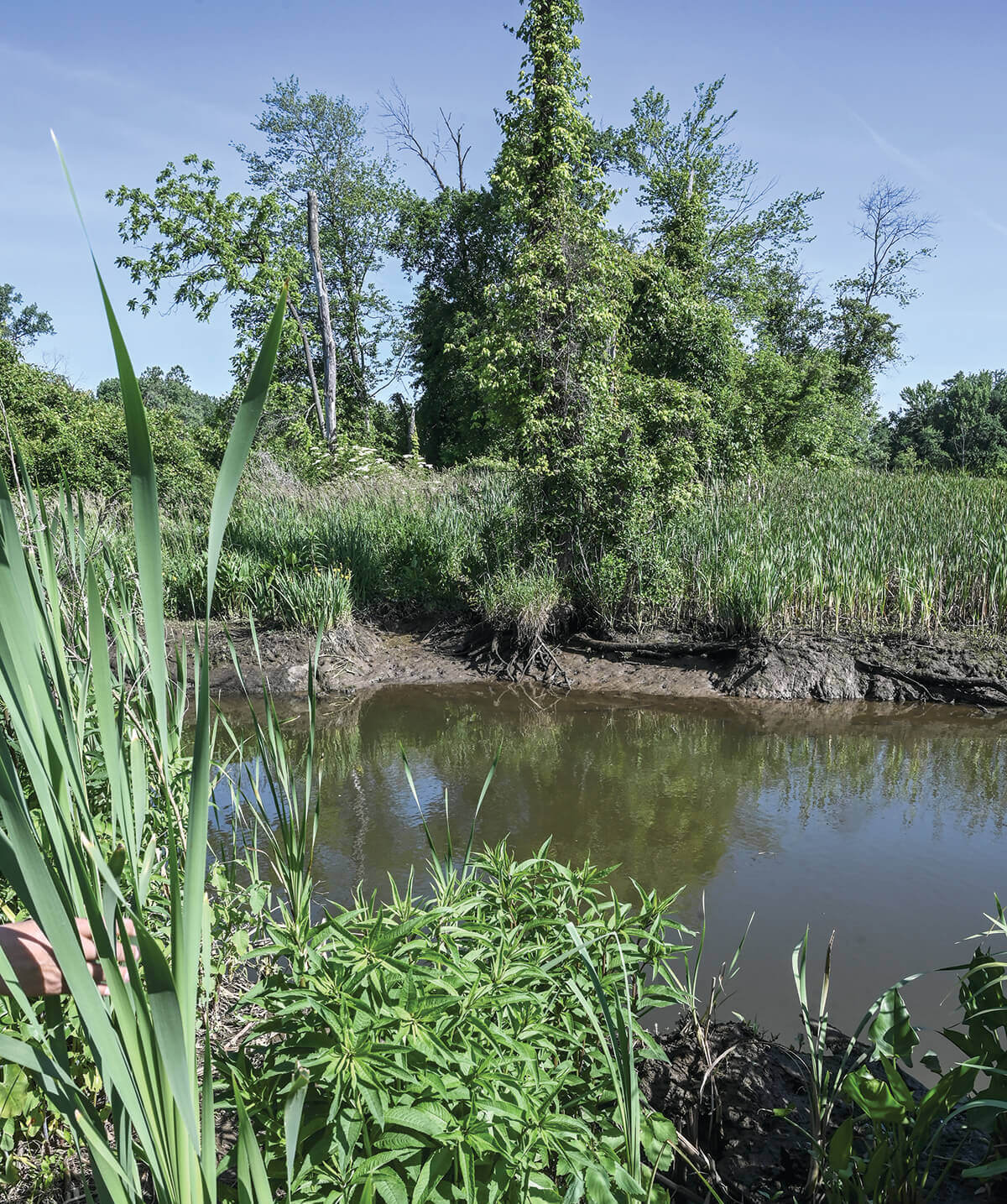
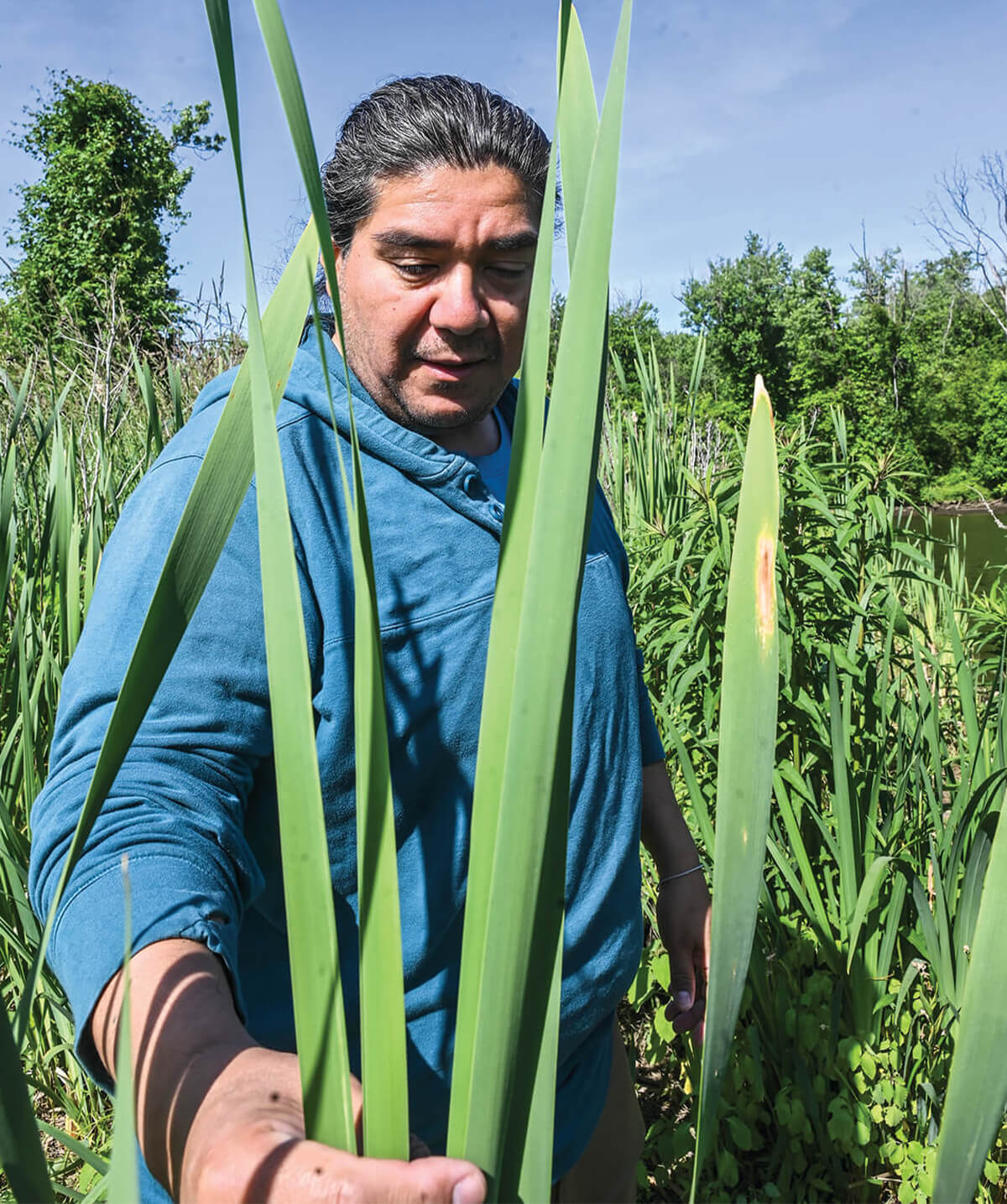
THE LATINO POPULATION in Baltimore doubled between 2010 and 2020 to over 40,000 people. A Pew Research study recently noted that climate change is a pressing concern for the majority of U.S. Latinos and that many see the effects of it in their communities. Yet there appears to be a gap between awareness and activism. If Defensores de la Cuenca, or Defenders of the Watershed in English, has its way, that’s going to change.
Latinos often come from cultures where reuse is part of everyday life, as is a close connection with nature, making it a community ripe to pick up the mantle of environmental leadership. But according to Abel Olivo, pictured above, Defensores co-founder and executive director, “The communities that are most impacted are not at the table, and there’s a reason for that. It’s historical exclusion, but also the structures and systems have been set up to make this work inaccessible.”
Olivo explains that even well-intentioned programs rarely take into account what matters in Spanish-speaking communities. Defensores programs are always free, fun, family-friendly, in Spanish, and take place at times that aren’t during work and church hours. “We’re asking these participants for their most precious commodity—their time,” says Olivo. “Time is food on the table, it’s rent, it’s a car payment; all that has real impact to community members on the margin.”
Over a year ago, Defensores began its Baltimore-based community-centered outreach, like water-quality investigations, picnics, and hiking excursions, but the end game is to bring the Latino community into Defensores’ paid programs to engage them in the economic engine of environmentalism. In July, in partnership with Patterson Park Audubon Center, Defensores will launch its La Academia de Defensores paid adult training program. Through in-person and virtual workshops, up to 15 participants earn a living wage while learning about watershed-related issues. At the conclusion, they implement a capstone project relevant to their community.
“In terms of climate change and resiliency, we need to better equip this community to be a part of the workforce, to be part of the conversation,” says Olivo. “If we continue to sideline or ignore the Latino and Spanish-speaking community, if we continue to ignore their need to access green space, to improve air and water quality, it will result in a sicker populace.”
